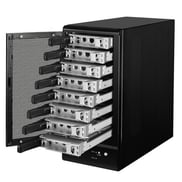 RAID, or redundant array of independent/inexpensive disks, was created to combine cheaper drives into a single, higher capacity drive. RAID was also designed to prevent fault, so that data on the drives would remain usable, even if the drive failed. As we all know, failures happen, so redundancy is important.
RAID, or redundant array of independent/inexpensive disks, was created to combine cheaper drives into a single, higher capacity drive. RAID was also designed to prevent fault, so that data on the drives would remain usable, even if the drive failed. As we all know, failures happen, so redundancy is important.
RAID has levels which mark the way drives are put together in order to improve performance and redundancy. Expansion cards make it easy to add RAID support to any system via a PCI-E slot.
Most motherboards have built-in support for RAID. Even if your motherboard does not have built-in support, software RAID can still be an option.
Before installing RAID on a configured system, make sure your data is backed up, just in case something goes wrong during setup. Remember RAID does not replace a backup. RAID protects from drive failure, not human error or security issues. Lastly, you cannot just add another drive to an existing array; you would have to reformat the array.
There are standard RAID levels, as well as multiples. Lucky for you, we’ve created an eBook to break down the different types of RAID.











